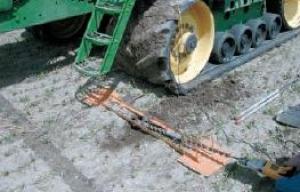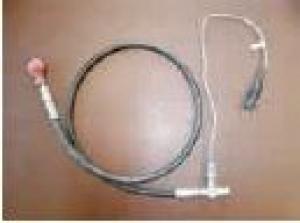Simple Sensor Measures Compaction
Canadian engineers have developed an easy-to-use sensor to detect excess soil compaction. The Ground Pressure Sensor can be used to help farmers decide when to start field work in the spring or when to return to a field after rain, says Reed Turner, Ag Tech Centre engineer, Lethbridge, Ontario.
"Hopefully we can reduce the risk of soil compaction by giving producers tools to quickly measure soil compactability," says Turner, lead developer of the sensor.
The sensor consists simply of a fluid-filled 1-in. dia. rubber bulb attached to a pressure transducer by a short high-pressure hose. A specially-designed drill bit is used to insert the bulb into the soil. Pressure on the bulb is read by either an electronic sensor or a simple dial pressure gauge.
Placed ahead of a piece of equipment, readings can provide a "time history" as the equipment moves over the sensor. Peak pressures can be used to judge the compaction force, while residual pressure (the net pressure remaining on the sensor after the vehicle has passed by) indicates compactibility and net compaction of the soil.
Sensor readings can compare the impact of different wheel configurations, lug patterns or tire surfaces. Turner estimates that two people can log 10 to 20 separate readings in as little as 20 to 30 minutes.
In the past, soil compaction measurement has been complex and time consuming, forcing farmers to rely on experience or rule of thumb. The researchers hope the new tool will aid farmers and serve as a teaching tool for dealing with compaction issues.
Contact: FARM SHOW Follow-up, Reed Turner, Agricultural Technology Centre, 3000 College Drive South, Lethbridge, Alberta, Canada T1K 1L6 (ph 403 329-1212; fax 403 328-5562).

Click here to download page story appeared in.
Click here to read entire issue
Simple Sensor Measures Compaction CROPS Miscellaneous 26-4-9 Canadian engineers have developed an easy-to-use sensor to detect excess soil compaction. The Ground Pressure Sensor can be used to help farmers decide when to start field work in the spring or when to return to a field after rain, says Reed Turner, Ag Tech Centre engineer, Lethbridge, Ontario.
"Hopefully we can reduce the risk of soil compaction by giving producers tools to quickly measure soil compactability," says Turner, lead developer of the sensor.
The sensor consists simply of a fluid-filled 1-in. dia. rubber bulb attached to a pressure transducer by a short high-pressure hose. A specially-designed drill bit is used to insert the bulb into the soil. Pressure on the bulb is read by either an electronic sensor or a simple dial pressure gauge.
Placed ahead of a piece of equipment, readings can provide a "time history" as the equipment moves over the sensor. Peak pressures can be used to judge the compaction force, while residual pressure (the net pressure remaining on the sensor after the vehicle has passed by) indicates compactibility and net compaction of the soil.
Sensor readings can compare the impact of different wheel configurations, lug patterns or tire surfaces. Turner estimates that two people can log 10 to 20 separate readings in as little as 20 to 30 minutes.
In the past, soil compaction measurement has been complex and time consuming, forcing farmers to rely on experience or rule of thumb. The researchers hope the new tool will aid farmers and serve as a teaching tool for dealing with compaction issues.
Contact: FARM SHOW Follow-up, Reed Turner, Agricultural Technology Centre, 3000 College Drive South, Lethbridge, Alberta, Canada T1K 1L6 (ph 403 329-1212; fax 403 328-5562).
To read the rest of this story, download this issue below or click
here to register with your account number.








